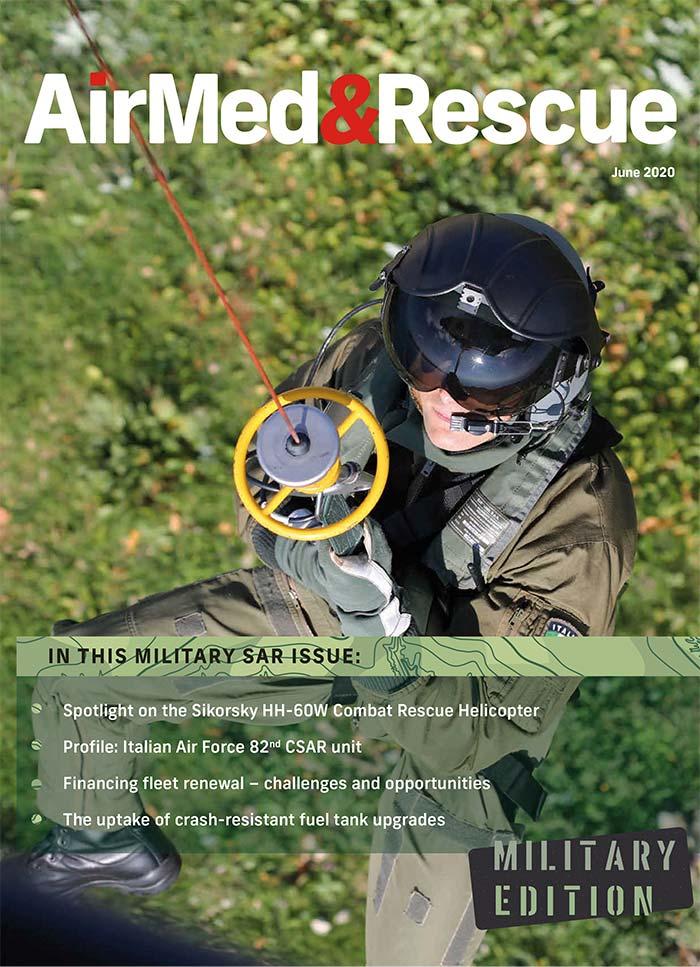Provider Profile: Italian Air Force CSAR unit

Dino Marcellino reports on his visit to the Italian Air Force’s Combat Search and Rescue Squadron
The 15th Wing is the biggest Italian Air Force Unit, with its main base at Cervia and four detachments (SAR centers). The Wing’s helicopter fleet comprises three models: the heavy HH-101A, the HH-139A and the HH-212; the latter are concentrated at the Decimomannu base in Sardinia and will be replaced by the new HH-139A currently on order. The SAR centers are operative 24 hours a day, 365 days a year.
The main task of 15th Wing is the safe and effective execution of search and rescue (SAR) operations within Italy’s borders and over national and international waters, with readiness to be deployed outside Italy for combat SAR missions. Additionally, the Wing provides support to other State organizations during natural disasters.
The Covid-19 emergency is an example of such extraordinary deployments: the HH-101s have been used extensively for the transport of infected patients, thanks to its large cabin that can comfortably accommodate complex bio-containment transport systems, which are used by the Air Force mainly onboard KC-767 and C-130J planes.
Significantly, the SAR centers are located around the Peninsula and two main islands, providing coverage of the entire Italian territory. One of them is of particular interest due some peculiarities that separates it from the other Centers: the 82nd SAR center based within the military area of the Trapani-Birgi International Airport on the island of Sicily. Each CSAR Center has its own radio call-sign: that of 82nd is ‘Jedi’.
The base is also home to the 37th Fighter Wing, which fly Eurofighter Typhoons – an important reason for the presence of a helicopter rescue unit on the same base, due to the higher-than-normal volume of air traffic.
Sicily is the largest Italian region and biggest island in the Mediterranean Sea, with more than five million inhabitants; situated at the crossroads of international shipping lanes and migratory movements. It is easy to understand, therefore, why the 82nd are called upon so frequently – the aforementioned characteristics inevitably result in a high mission volume, with most of the missions carried out in prohibitive weather conditions.
Another difference from the rest of Italy is that the six regional civilian helicopters that are used for HEMS throughout the biggest island – and a lot of minor islands and archipelagos – are not equipped with hoists nor night vision imaging systems (NVIS); thus, the 82nd CSAR is a vital resource in SAR missions, day and night, over land and sea.

To accomplish its missions, the three HH-139As are – in addition to hoist equipment and NVIS – equipped with searchlights and FLIR, a stretcher and collapsible rescue basket, hoist rescue collar, evacuation triangle, and a pneumatic raft, which seats 10.
The standard crew is a pilot in command, second pilot, hoist operator and a rescuer named ARS (Aerosoccorritore). The ARS personnel are trained and qualified to operate in any environment, from swimming and diving, to rock climbing and alpine skiing. The ARS must be able to provide medical first aid if necessary. From a military point of view, ARS are also qualified in the use of small arms, self-defence, patrolling, and SEFRI/Survival Escape and Resistance to Interrogation. Depending on the type of mission, a second ARS can be embarked.
The 82nd CSAR, as well as other Centers, trains periodically with members of CNSAS, the National Mountain Rescue and Speleological organizations.
Another peculiarity of the 82nd is that since 2018, the Center have been signatory to an agreement with the Sicilian Region’s authority to assist in aerial fire fighting. The 82nd is thus the first Air Force Unit to equip an HH-139A with a 1,000-liter Bambi Bucket.
Images © Dino Marcellino

June 2020
Issue
In this Military Edition:
- Feature: HH-60 Combat Rescue Helicopter
- Military SAR, a look ahead
- Provider Profile – Italian Air Force
- Crash-resistant fuel tank uptake
- Lease or buy - renewing air medical fleets
- First-pass success in pre-hospital intubation
- Case Study: PIU repatriation of fully ventilated patient
Dino Marcellino
Known around the world for his aviation photography and reports, Dino Marcellino has been fascinated by aircraft since his childhood, and has spent his life combining his passion for aircraft with that of photography. Flying on more than 25 different types of helicopters, he has worked with the Italian Navy, Army and Air Force, as well as police and rescue organisations.

